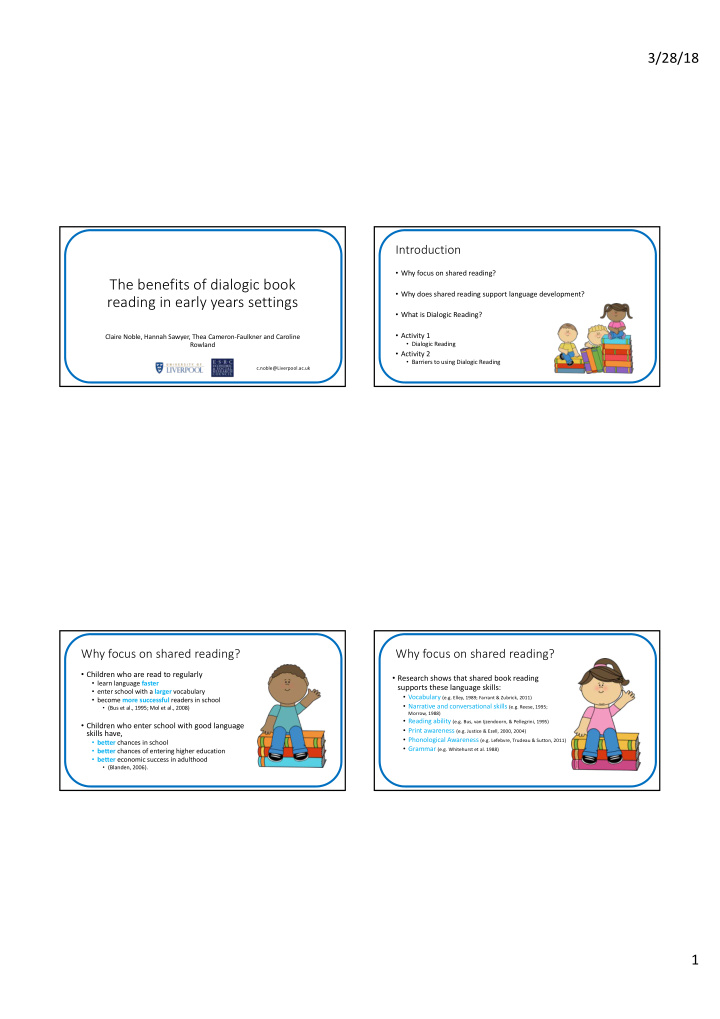



3/28/18 Introduction • Why focus on shared reading? The benefits of dialogic book • Why does shared reading support language development? reading in early years settings • What is Dialogic Reading? • Activity 1 Claire Noble, Hannah Sawyer, Thea Cameron-Faulkner and Caroline • Dialogic Reading Rowland • Activity 2 • Barriers to using Dialogic Reading c.noble@Liverpool.ac.uk Why focus on shared reading? Why focus on shared reading? • Children who are read to regularly • Research shows that shared book reading • learn language faster supports these language skills: • enter school with a larger vocabulary • Vocabulary (e.g. Elley, 1989; Farrant & Zubrick, 2011) • become more successful readers in school • Narrative and conversational skills (e.g. Reese, 1995; • (Bus et al., 1995; Mol et al., 2008) Morrow, 1988) • Reading ability (e.g. Bus, van Ijzendoorn, & Pellegrini, 1995) • Children who enter school with good language • Print awareness (e.g. Justice & Ezell, 2000, 2004) skills have, • Phonological Awareness (e.g. Lefebvre, Trudeau & Sutton, 2011) • better chances in school • Grammar (e.g. Whitehurst et al. 1988) • better chances of entering higher education • better economic success in adulthood • (Blanden, 2006). 1
3/28/18 Why does shared reading support language Dialogic Reading development? • Aim - to make the child the storyteller and adult becomes • We don’t really know WHY, we just know it does the listener, questioner and the audience for the child • Maybe, • Reading exposes child language they don’t normally hear in everyday speech • The technique follows this sequence • Cameron-Faulkner & Noble (2013); Hoff-Ginsberg (1991) • P rompts the child to say something about the book, • Reading helps parents to be contingent and promotes joint attention • E valuates the child's response, • McGillion et al. (2013); Tomasello & Farrar (1986) • E xpands the child's response by rephrasing and adding information • Both of these and other factors contribute! to it, and • R epeats the prompt to make sure the child has learned from the expansion. Dialogic Reading Dialogic Reading • Prompts • Large volume of evidence to support this technique • Completion • Vocabulary development (e.g. Whitehurst et al. 1988; Vally et al., 2015) • Recall • Narrative development (e.g. Zevenbergen, Whitehurst & Zevenebergen, 2003) • Open ended • Print concepts (e.g. Sim et al., 2014) • Wh-Questions • Distancing • Can be practitioner led (e.g. Valdez-Menchaca & Whitehurst, 1992) • Can be used in small groups (e.g. Hargrave & Sénéchal, 2000) • Can be parent led (e.g. Whitehurst, 1988) 2
3/28/18 Dialogic Reading Activity Barriers Activity • Work in groups to create a plan for a dialogic reading session • Work in groups to discuss these questions • Come up with some prompts you could use on each page • What do you think would be the main barriers to implementing dialogic reading in your role? • Completion • Recall • Open ended • How would you overcome these barriers? • Wh-Questions • Distancing • Select some vocabulary for each page Resources • This link contains a video of how to do dialogic reading • https://mypearsontraining.com/products/read-together/tutorials/detail/read-together-talk- together-teacher-training-video • This link contains a YouTube video of how to attach prompts to a book so that dialogic reading can take place. • http://highlandliteracy.com/2014/08/18/dialogic-reading/ • A list of popular dialogic reading books. There are quite a few of these lists online. • https://www.goodreads.com/shelf/show/dialogic-reading • This link contains a template to use when doing dialogic reading. There are other templates available on other websites too. • https://researchparent.com/dialogic-reading-cheat-sheet/ 3
More recommend